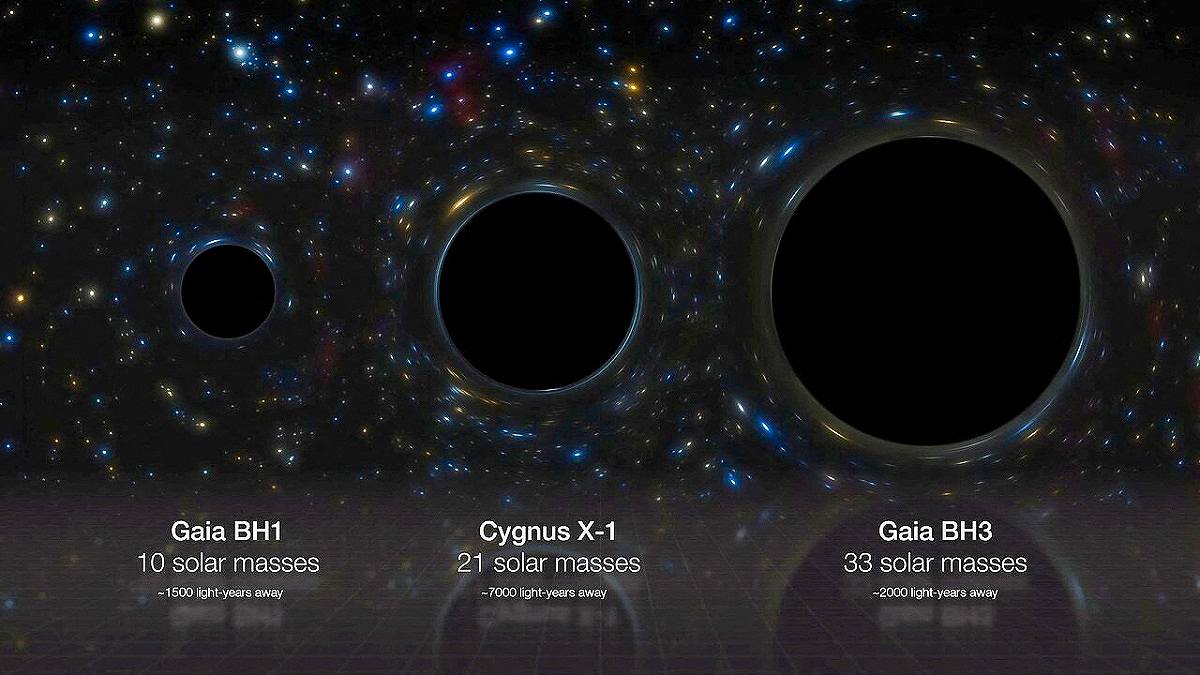
The orbits of the most massive stellar black hole in our galaxy, dubbed Gaia BH3, and a companion star, are seen in this artist’s image obtained on April 16.
11:25 JST, May 3, 2024
WASHINGTON (Reuters) — Astronomers have discovered a black hole with a mass about 33 times greater than that of our sun, the biggest one known in the Milky Way aside from the supermassive black hole lurking at the center of our galaxy.
The newly identified black hole is located about 2,000 light-years from Earth — relatively close in cosmic terms — in the constellation Aquila, and has a companion star orbiting it, researchers said on April 16.
Black holes are extraordinarily dense objects with gravity so strong that not even light can escape, making it difficult to spot them. This one was identified through observations made in the European Space Agency’s Gaia mission, which is creating a huge stellar census, because it caused a wobbling motion in its companion star. Data from the European Southern Observatory’s Chile-based Very Large Telescope and other ground-based observatories were used to verify the black hole’s mass.
“This black hole is not only very massive, it is also very peculiar in many aspects. It is really something we never expected to see,” said Pasquale Panuzzo, a research engineer at the French research agency CNRS working at the Observatoire de Paris and lead author of the study published in the journal Astronomy & Astrophysics.
For instance, the black hole, called Gaia BH3, and its companion are traveling within the galaxy in the opposite direction of how stars typically orbit in the Milky Way.
Gaia BH3 probably formed after the death of a star that was more than 40 times as massive as the sun, the researchers said.
Black holes that result from the collapse of a single star are called stellar black holes. Gaia BH3 is the largest-known stellar black hole, according to astronomer and study coauthor Tsevi Mazeh of the Tel Aviv University in Israel.
Stellar black holes are dwarfed in size by the supermassive black holes inhabiting the center of most galaxies. One such black hole called Sagittarius A*, or Sgr A*, is located at the heart of the Milky Way. It possesses 4 million times the mass of our sun and is located about 26,000 light-years from Earth.
Gaia BH3’s progenitor star was composed almost entirely of hydrogen and helium. Stars in the early universe had such a chemical composition, known as low metallicity. This star had formed relatively early in the universe’s history — perhaps 2 billion years after the Big Bang event.
When that star exploded at the end of its lifespan — called a supernova — it blasted some material into space while the remnant violently collapsed to form a black hole.
The discovery of Gaia BH3, according to Panuzzo, supports stellar evolution models showing that massive stellar black holes can be produced only by a low metallicity star like this one’s progenitor star.
Gaia BH3’s companion star, just as old as the other one was, is about 76% of the mass of the sun and a bit colder, but around 10 times more luminous. It orbits the black hole on an elliptical path at a distance varying between about 4.5 times the distance between Earth and the sun — a measure called an astronomical unit (AU) — and 29 AU. By way of comparison, Jupiter orbits around five AU from the sun and Neptune around 30 AU.
“The surprising result for me was the fact that the chemical composition of this companion star does not show anything special, so it was not affected by the supernova explosion of the black hole,” Observatoire de Paris astronomer and study coauthor Elisabetta Caffau said.
Scientists are not sure just how big stellar black holes can be.
“The maximum mass for a stellar black hole is a matter of active scientific debate,” Panuzzo said.

An artist’s impression compares side-by-side three stellar black holes in our galaxy: Gaia BH1, Cygnus X-1 and Gaia BH3, whose masses are 10, 21 and 33 times that of the sun respectively.
"Science & Nature" POPULAR ARTICLE
-

Genome Study Reveals Milestone in History of Cat Domestication
-

Big Leap in Quest to Get to Bottom of Climate Ice Mystery
-

Security Camera Footage Vulnerable to Outside Access; Investigation Finds 3,000 Pieces Exposed Online
-

Paws on Parade: Nairobi’s Dogs Dazzle at ‘Pawchella’
-

Japanese Eels Escape New Regulation in Vote at CITES Meeting, Avoiding Higher Prices for Dealers and Diners
JN ACCESS RANKING
-

Keidanren Chairman Yoshinobu Tsutsui Visits Kashiwazaki-Kariwa Nuclear Power Plant; Inspects New Emergency Safety System
-

Imports of Rare Earths from China Facing Delays, May Be Caused by Deterioration of Japan-China Relations
-

University of Tokyo Professor Discusses Japanese Economic Security in Interview Ahead of Forum
-

Japan Pulls out of Vietnam Nuclear Project, Complicating Hanoi’s Power Plans
-

Govt Aims to Expand NISA Program Lineup, Abolish Age Restriction






















